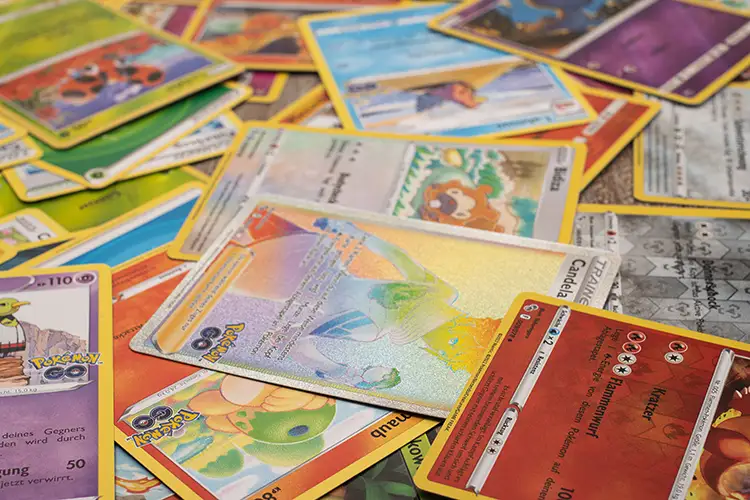
By Hallie Forcinio, writer, PostPress
Segments of the printing industry are cautiously optimistic about the next few years. Sales revenue for commercial printing, direct mail, greeting cards, trading cards, and folding cartons and packaging is expected to grow. One contributing factor is the increased use of embellishments, particularly combinations of decorative technologies.
Brand owners like embellishments because they connect with customers. In the direct mail segment, this success is confirmed by real-world statistics. The US Postal Service (USPS) cites studies showing increases in response rates of 10–30% for mailers using some form of embellishment. Lob, www.lob.com, a direct mail platform, reported its client, Lovesac, achieved a 300% increase in sales after incorporating embellishments like foil printing and textured paper. Who’s Mailing What!, a trade publication, mentions a study where a textured cover letter increased response rates by 52%.
According to Andrew Schipke, vice president marketing and strategic sales at W+D North America, Inc., another driving force for direct mail is the USPS itself, which has been promoting usage by offering postage discount incentives (5% in 2024). Details about the Promotions & Incentives Programs for First Class® and USPS Marketing Mail® may be found at https://postalpro.usps.com/promotions.
For greeting cards, embellishments continue to drive sales and pricing as millennials look for differentiated cards that reflect who they are, as well as their relationship with the recipients of their cards.
Commercial printing
The commercial printing segment likely declined a bit in 2023, and general periodicals will continue to slide. However, 2024 should show positive growth since it’s an election year. A transition from high-volume jobs to added-value jobs also is occurring. Thus, digital finishing and embellishment will continue to be highly desirable elements because printers win business by setting themselves apart from their competition. “Marketers and brands want differentiation,” explained Thayer Long, president of the Association for Print Technologies.
Marketers also are dealing with omnichannel campaigns and looking for print support. “This is spurring a trend away from mass production and more toward mass customization – variable print, etc.,” Long said. As a result, printers continue to invest in software and workflow improvements as well as automation, especially on the finishing side of the business, to expand hands-free operation and lower labor requirements. Long also predicts a growing role for artificial intelligence (AI), which already is developing marketing collateral.
Direct mail
 The USPS reports 56% of the 105 billion pieces of mail it handled in 2023 were marketing pieces. So, it’s no surprise that direct mail has paralleled the strength of the economy even though postage increases have reduced overall mail volumes in recent years.
The USPS reports 56% of the 105 billion pieces of mail it handled in 2023 were marketing pieces. So, it’s no surprise that direct mail has paralleled the strength of the economy even though postage increases have reduced overall mail volumes in recent years.
Direct mail will continue to grow, particularly as changes in privacy laws limit how search engines use data for retargeting. With less retargeting allowed, marketers will be forced to look for other ways to put their message in front of customers. “Everyone has an address, everyone has a mailbox, everyone has to get mail every day,” explained Long.
He said this makes direct mail the ideal solution because it offers:
- “High response rates: Compared to digital ads, direct mail boasts significantly higher response rates, making it attractive for marketers seeking engagement. With digital fatigue on the rise, physical mail can stand out and capture attention effectively.
- Personalization potential: Advanced data and technology enable highly personalized mail campaigns, leading to increased relevance and impact. This is the next big wave in direct mail and will be driven by new AI and inkjet printing capabilities.
- An omnichannel integration approach by marketers: When combined with other marketing channels, direct mail can be a powerful part of a comprehensive strategy.”
Financial services, banking, healthcare, insurance and nonprofits have been the biggest users of high-volume direct mail and rely on it for both customer acquisition and retention. Schipke explained, “With customer acquisition costs on the rise, marketers are using direct mail campaigns strategically as part of an omnichannel campaign to keep existing customers engaged with cross-sells, upsells, education and other value content that keeps the brand top of mind.”
For most marketers, direct mail delivers the best ROI, response and conversion rates of any marketing channel they use. “As we move forward,” Schipke predicted, “marketers that automate direct mail will reap the benefits of better response rates as the result of being able to create more targeted, personalized and trackable campaigns. We expect AI to play a major role in this automation.” QR codes, personalized URLs and customer activity in a given period are leading measurement tactics used by marketers who automate direct mail for campaign tracking and attribution. This means more 1:1 digitally printed direct mail pieces will find their way into mailboxes.
Greeting cards
 “The greeting card industry is in a good place,” reported Nora Weiser, executive director of the Greeting Card Association. She explained, “We have a record number of small makers in the industry, and while our largest card buyers by volume, baby boomers, are declining, our largest segment by dollars, millennials, are only now entering their primary card-buying life stages – getting married, having babies and buying a house – as they are now 29-42 years old. The demand for cards has remained strong because millennials have seized onto cards as a key vehicle to further relationships with their friends and family.”
“The greeting card industry is in a good place,” reported Nora Weiser, executive director of the Greeting Card Association. She explained, “We have a record number of small makers in the industry, and while our largest card buyers by volume, baby boomers, are declining, our largest segment by dollars, millennials, are only now entering their primary card-buying life stages – getting married, having babies and buying a house – as they are now 29-42 years old. The demand for cards has remained strong because millennials have seized onto cards as a key vehicle to further relationships with their friends and family.”
Unique, differentiated cards targeting this demographic appeal to this growing audience of card buyers. As a result, smaller manufacturers and retailers focused on millennials are seeing the strongest growth. Embellishments provide the type of differentiation they want when seeking that ‘perfect card’ to send to their ‘card-worthy’ friends. “When art, editorial and embellishments come together to create the perfect design for senders to show they were thinking about the recipients and their relationship, the magic happens – and the sale!” Weiser said.
Based on these trends and millennial preferences, she predicted, mass market card sections in major retailers (e.g., Walmart and Kroger) will shrink, but the number and variety of retailers carrying greeting cards will continue to expand. Embellishments will drive sales and pricing. “Consumers still value the tactile quality of greeting cards as a way to further their key relationships,” Weiser said.
Despite this positive trend, the greeting card segment faces challenges, with the first being to convince retailers of all sizes and types that greeting cards will sell well for them. Another major hurdle is the health of USPS, which traditionally has delivered nearly 60% of purchased greeting cards to their final recipient. However, Weiser noted, “The rapid price increases, deterioration of service and the inability of USPS to handle thicker, heavier and odd-sized envelopes with the types of unique cards today’s buyers prefer are combining to make it much more difficult for consumers to send the card they want to their friends and family. If that continues, it will put a lot of negative pressure on card sales. It is hard to envision an alternative that can deliver to any household in the US, quickly and at a reasonable price, so our efforts focus on halting the negative slide at USPS.”
Weiser concluded, “Overall, greeting card volume may remain flat or be slightly down over the next decade, but overall greeting card dollar sales likely will continue to enjoy a slow increase. In short, the next five to 10 years are a good time for small makers and the suppliers that can help them produce unique, differentiated cards for the millennial market. Small retailers that cultivate a strong base of female customers with money and taste and carry greeting cards that cater to them also will do well. As millennials fully enter their prime ‘kin-keeping’ years where card buying peaks, the changes seen over the last 10 years – more differentiated cards, more small makers and more retailers of all types carrying cards – will accelerate, benefitting greeting card makers, manufacturers and retailers alike.”
Trading cards
 The trading card segment is divided into sports cards and collectible or trading card game cards. Sports cards cover all major US sports plus European football. The collectible and trading card game segment includes Pokémon, Yu-Gi-Oh!, Magic: The Gathering and Marvel Champions. Both segments are experiencing healthy sales and are likely to see high single-digit or low double-digit growth during the next two to five years, according to Stefan Congram, global director – Design Centers & NPI at Cartamundi Group.
The trading card segment is divided into sports cards and collectible or trading card game cards. Sports cards cover all major US sports plus European football. The collectible and trading card game segment includes Pokémon, Yu-Gi-Oh!, Magic: The Gathering and Marvel Champions. Both segments are experiencing healthy sales and are likely to see high single-digit or low double-digit growth during the next two to five years, according to Stefan Congram, global director – Design Centers & NPI at Cartamundi Group.
Each card type has a different audience with its own hierarchy of interest from casual to intense. On the game side, for example, casual players enjoy an occasional game. Moving to the next levels of interest, invested players spend a lot of time playing, followed by fanatics. At the top of the hierarchy are ‘whales,’ people with means who will spend almost any amount on something rare. “Rarity and the perception of value are what are driving the markets right now,” Congram said.
On the sports side, football, baseball and basketball cards are in high demand, with purchases often driven by the desire to acquire a card for a specific player like Victor Wembanyama, the 7-foot, 4-inch French rookie who plays center for the San Antonio Spurs.
Embellishments, particularly foil supported by gloss or matte elements, are important features on sports and trading card game cards. “Everyone is looking for what’s next and wants something unique, particularly for ‘chase’ cards,” Congram said. In addition, he said, “Serialization is a big draw in both spaces because when you see a numbered card, you know how rare it is.” Serialization also is used for the signature of the artist who created the artwork.
“We’ve seen a shift toward digital embellishment [serialization and signatures],” Congram said, who predicted this trend will continue and gain momentum due to the large impact it provides.
Folding carton/packaging
 Extended Producer Responsibility laws in the US may negatively impact folding carton volumes as marketers eliminate the use of folding cartons for some secondary packaging applications, e.g., bottles in cartons. However, any decline is likely to be offset by the adoption of renewable and recyclable folding cartons as an alternative to non-recyclable packaging. As a result, the folding carton market should see steady growth of 5% per year globally and in the US, according to Adam Peek, senior vice president of sales at Meyers, a third-generation family-owned printer with an in-house design studio.
Extended Producer Responsibility laws in the US may negatively impact folding carton volumes as marketers eliminate the use of folding cartons for some secondary packaging applications, e.g., bottles in cartons. However, any decline is likely to be offset by the adoption of renewable and recyclable folding cartons as an alternative to non-recyclable packaging. As a result, the folding carton market should see steady growth of 5% per year globally and in the US, according to Adam Peek, senior vice president of sales at Meyers, a third-generation family-owned printer with an in-house design studio.
While the market may be strong, the use of embellishments is under pressure due to cost-control efforts. So, more folding cartons are being printed standard 4-color offset or 7-color ECG (extended color gamut) printing, often in gang runs. “For a lot of brands, digital printing would be best, but there hasn’t been near the adoption rate of digital printing of cartons that we’ve seen for labels, corrugated, shrink sleeves and flexible packaging,” Peek said. However, he predicted, “Quick-turn digital will gain traction if the technology evolves.”
Either way, embellishments will continue to be an important tool, particularly for printers that can add them with minimal impact on pricing. Marketers need shelf impact to sell products; embellishments deliver that impact.
Like other segments of the industry, folding carton companies will need to focus on automation, workflows and building relationships up and down the industry (suppliers and customers). Peek said such efforts will be imperative to withstand the economic turbulence on the horizon, which is being driven by China’s aging population and the US debt.

